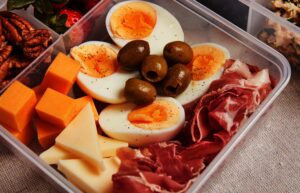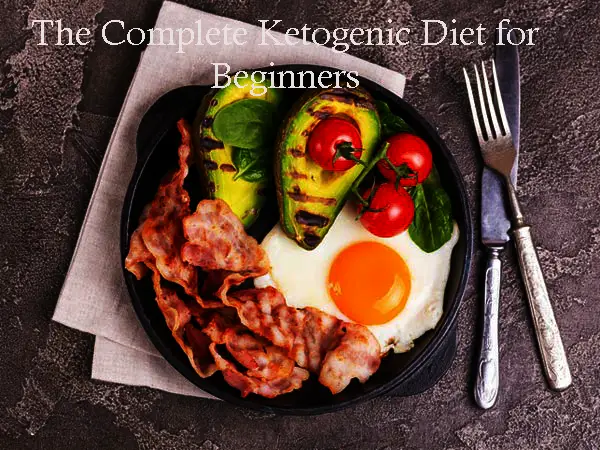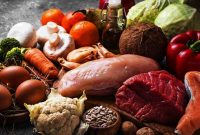The ketogenic (keto) diet is a low carb, high-fat meal plan linked with many potential health benefits. In recent years a lot of people have turned into the ketogenic diet to help with weight loss and enhance many other health conditions.
The Complete Ketogenic Diet for Beginners
Having a great number of meals off-limits, the keto diet requires a lot of meal planning and attention to detail to enter the appropriate metabolic condition and turn your body into a fat-burning machine.
How can you get started on a keto diet? Is it a fad or a sustainable long-term eating routine? Does it actually help you lose weight?
What Is a Ketogenic Diet?
A ketogenic diet is a high fat, moderate protein diet, low carb diet plan. Researchers found that when kids with epilepsy followed an extremely high fat keto diet, their seizures became more manageable or stopped entirely.

The keto diet remained a popular treatment for epilepsy before the 1940’s when new anti-inflammatory medicines became available. These medications were easier for kids to stick with. As a result, the keto diet saw its popularity decline over time. It stayed comparatively forgotten before the early 1970s. This publication highlighted the advantages of the Atkins diet, a low carb, high-fat eating program. The Atkins diet quickly became a remarkably popular option for weight loss.
Since then the keto diet, a low carb high-fat diet very similar to Atkins, is now a popular choice for people seeking to lose weight and enhance their health.
Observing a ketogenic diet is not just about limiting carbohydrate intake. The purpose is to transition our own body into a fat-burning manner called ketosis. To do this the majority of your calories have to come from fat.
In ketosis, your body burns fat for energy instead of sugar. Some parts of our body such as our mind can only use blood glucose as an energy source. On a really low carb, detour liver begins to produce compounds called ketone bodies to provide the necessary energy to those cells.
The health benefits of following a ketogenic diet include the general reduction in energy intake and the very low carbohydrate driven condition of ketosis.
How Can I Start a Keto Diet?
To start on a keto diet and reach ketosis, the majority of individuals need to restrict their overall carb intake to somewhere between 20 and 50 grams every day. For many, this means 5% to 10% of total energy consumption can come from carbohydrates.

Begin by reading nutrition labels and accurately counting how many carbohydrates you’re currently eating every day. It’s ideal to monitor your food intake to make sure you are receiving the proper ratio of macronutrients.
The suggested macronutrient ranges for a ketogenic diet are 10% carbohydrates, 20% protein, and 70% fat (two ). It is very important to point out that there is not any”standard” ketogenic diet. The continuous factors are moderate protein and low adequate carbohydrate intake to put in a state of ketosis.
The average American diet is composed of 55% carbohydrates, 15% protein, and 30 percent fat. Changing to a ketogenic low carbohydrate eating plan takes a significant change in our food consumption since the majority of people don’t consume an extremely high-fat diet.
Daily intake of protein needs to remain moderate at around 20 percent of total calories. For a 2,000 calorie diet, this equates to approximately 100 grams of protein every day.
Too much protein can prevent our body from entering into ketosis and burning fat as a fuel source. Our bodies can create blood glucose from parts of proteins known as amino acids.
We will need to make sure we supply our bodies with sufficient protein to maintain muscle mass but prevent having a lot of that ends up being converted into blood sugar.
Ketogenic diets are different from other cool low-carb diets like Paleo that have more balance between carbohydrates, proteins, and fats.
Our body stores a little bit of sugar in cells, mainly in the liver. The storage type of blood sugar in your system is called glycogen. Once you begin an extremely low carb diet takes one to two days for the body to use up all of its stored glycogen.
Once glycogen stores have been depleted, our body begins burning fat for energy. At the exact same time, our liver starts creating ketones and we’re in a state of ketosis.
What Foods Contain Carbs?
Here’s a listing of high-carb foods. The majority of these foods will need to be removed on a diet for keto.
- Bread and Grains
- Fruit and Fruit Juice
- Starchy Vegetables (potatoes, corn, peas)
- Beans and Legumes
- Pasta
- Cereal
- Dairy
- Beer
- Salad dressings with Additional sugar
- Honey, granulated sugar, or alternative calorie-containing sweeteners
- Chips, crackers
- Baked goods
- Ice cream
One serving of fruit, equivalent to a tennis ball-sized apple or orange, 1 cup of berries or half of the banana includes 15 grams of carbohydrates.
1 cup of milk, a piece of bread, or 1/3 cup of cooked rice also contains 15 grams of carbohydrates.
When making a keto diet, be sure you’re accounting for all these foods and limit them to no longer than one serving per day. Depending on the number of carbohydrates you are getting from other foods you might not be able to get any in the beginning stages.
You may have heard people talking about total carbs and others talking about web carbs when discussing ketogenic diets.
Total carbohydrates refer to the number of carbohydrates in food. As an instance, an avocado includes 11.6 grams of total carbohydrates. This is how to calculate carbs.
What Are Net Carbs?
Many foods that contain carbohydrates additionally contain fiber. While fiber consumption is incredibly important for gut health, fiber isn’t digestible by our own bodies therefore it will not raise blood sugar levels or supply energy for our body.
Many people suggest subtracting the amount of fiber in food and just counting the carbs that are digestible toward the daily limit of 20 to 50 g daily.
This number is called net carbs.
For example, a whole avocado includes 11.6 grams of total carbs. But it comprises 9.1 grams of fiber. One whole avocado contains just 2.5 g of net carbs.
What if you do?
Many proponents of ketogenic diets recommend beginning with 20 to 50 grams of total carbohydrates per day.
Following a period of time where you are consistently in ketosis, then you may start increasing your carbohydrate count and carefully monitor your amounts of ketones. Continue to modify your intake until you find the right total number of net carbs daily that is appropriate for your entire body. If you come from ketosis you’re eating too many carbs.
While there are lots of high carb foods which have to be prevented, there are a huge array of foods which are keto-friendly.
What Are Keto-Friendly Foods?
Most of your calories on a ketogenic diet will come from eating a lot of fat and also a moderate quantity of protein. Here are the keto foods that match with a ketogenic diet.
- Meats and proteins such as beef, chicken, turkey, and pork
- Cheese
- Fatty fish
- Eggs
- Avocados
- Mushrooms
- Dark Chocolate
- Nuts and Seeds including walnuts, almonds, and peanuts
- Oils including coconut oil, olive oil, and butter
1 ounce of beef and fish contains 1 g of protein. 1 egg contains 6 grams of protein. Nuts and nut cheese and butter are also excellent low-carb protein resources.
For a 2,000 calorie diet, you also will need around 100 g of protein each day. You will have to monitor your ketone levels as soon as you’re in ketosis and fix your protein consumption if necessary.
On a keto diet, fat will constitute at least 70 percent of total energy intake. For a 2,000 calorie daily diet, this is around 155 grams of fat each day.
Keto-Friendly Vegetables
You may be asking yourself if vegetables are ok on a ketogenic diet. They’re filled with beneficial nutrients that our bodies need, but also have a small number of carbs.
On a ketogenic diet, it’s generally advised to avoid root vegetables, at least at the beginning.
A simple rule to remember is to stick with leafy vegetables such as leafy greens to start. Avoid any foods that grow under the ground.
You are still able to include a small number of root vegetables in your low carbohydrate foods, as an example, you may add chopped carrots into a wholesome keto stir fry.
What Are the Benefits of a Keto Diet?
The ketogenic diet requires you to cut many foods to be prosperous. This is also one of the reasons why people have so much success using a ketogenic diet.
A lot of people struggle with eating a lot of snack foods. After a ketogenic low-carb eating pattern, you completely eliminate them.
Moderation may seem like a fantastic plan but many people find it simpler to follow low carb diets that require them to completely drop foods that are bothersome.
Many folks begin a keto diet in order to lose weight. 1 recent analysis found that people following a ketogenic diet lost more weight than those after a low-carb diet plan and maintained weight loss for up to 24 months. The keto dieters also had improvements in markers of heart disease risk such as lower blood pressure and enhanced triglyceride levels.
There are many ways that a ketogenic diet may result in weight reduction. One is through a reduction in appetite. High-fat foods are far more filling. A recent analysis showed that individuals following a ketogenic diet have been less hungry and had improved appetite control.
This is essential because typically if we lose weight we are feeling hungry. Being in ketosis and eating more fat seems to help prevent this growth in hunger from happening.
Besides being an effective selection for weight loss, being in fat-burning mode with the keto diet may also help reduce stomach fat.
A current study assigned 148 people to both groups for a period of 12 months. The very first group followed a low-carb keto diet and the other followed a low-fat diet. In the close of the analysis, people who followed a low-carb keto diet shed more stomach fat than those following a low-carb diet.
There are other studies showing that a ketogenic diet may be beneficial for polycystic ovary syndrome, potentially help treat cancer and slow tumor growth, also enhance acne.
A recent analysis found that following a low-carb diet reduced many of the risk factors related to cardiovascular disease such as lowering triglyceride levels and raising HDL cholesterol levels.




